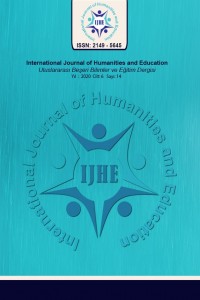Öz
VIII. yüzyıl, Bizans İmparatorluğu’nun hem içte hem de dışta ciddi saldırılara maruz kaldığı yüzyıldır. Bu yüzyılda imparatorluk, tahtı ele geçirmek isteyen ve ordunun desteğini alan isyancılarla karşılamış ve bu isyanların bazıları başarılı olurken bazıları da başarısız olmuştur. Başarılı olan isyancılardan birisi, İmparator III. Leo’nun ölümünden sonra isyan eden Armeniakon Theması Strategosu ve Opsikion Theması Komesi Artabasdos’tur. Artabasdos, Temmuz 741’den Kasım 743 yılına kadar hüküm sürmüştür. Artabasdos’un en önemli özelliği, Leo’nun başlatmış olduğu İkonaklazm dönemine ara vererek başşehir Konstantinopolis’te ikonaseverliği yeniden tesis etmesidir. Bu çalışma, III. Leo ile Artabasdos arasındaki ilişkileri, Artabasdos’un isyanı, isyanın gelişimi, Artabasdos’un İmparator olması, Konstantinopolis’teki faaliyetlerini, Konstantinos’un Artabasdos’u bertaraf etmesini ve bu isyanın İmparatorluk ve Anadolu tarihi açısından sonuçlarını değerlendirmektedir.
Anahtar Kelimeler
Kaynakça
- Referans1 Abû’l-Farac Tarihi, Çev. Ömer Rıza Doğrul, Ankara 1999.
- Referans2 The Life of Michael the Synkellos, Trans. Mary B. Cunningham, Belfast.
- Referans3 Short History, Texts, Trans. Comm. by Cyril Mango, Dumbarton Oaks 1990.
- Referans4 Les Listes de Préséance Byzantine des IXe et Xe Siécles
- Referans5 Chronique de Michel le Syrien, Patriarche Jacobite d’Antioche (1166-1199)
Öz
It was 8th century when the Byzantine Empire was subjected to serious attacks both inside and outside. In this century, the empire met with rebels who received the support of the army and wanted to seize the throne. Some of these revolts were, while others failed, successful. One of the victorious rebels, Artabasdos, who began to walk after the death of emperor Leo III, was strategos of Armeniac Theme and comes of Opsician Theme. Artabasdos was on the imperial throne from July 741 to November 743. The most important feature of Artabasdos was that he interrupted the Iconoclasm period initiated by Leo and reestablished Iconophile in the capital city, Constantinople. This study evaluates the relations between Leo III and Artabasdos, the rebellion of Artabasdos, the development of the rebellion, Artabasdos’s becoming the emperor, his activities in Constantinople, Constantine's elimination of Artabasdos and the consequences of this rebellion in terms of Empire and Anatolian history.
Anahtar Kelimeler
Byzantine Rebellion Leo III Artabasdos Constantine V Anatolia
Kaynakça
- Referans1 Abû’l-Farac Tarihi, Çev. Ömer Rıza Doğrul, Ankara 1999.
- Referans2 The Life of Michael the Synkellos, Trans. Mary B. Cunningham, Belfast.
- Referans3 Short History, Texts, Trans. Comm. by Cyril Mango, Dumbarton Oaks 1990.
- Referans4 Les Listes de Préséance Byzantine des IXe et Xe Siécles
- Referans5 Chronique de Michel le Syrien, Patriarche Jacobite d’Antioche (1166-1199)
Ayrıntılar
| Birincil Dil | Türkçe |
|---|---|
| Bölüm | Araştırma Makalesi |
| Yazarlar | |
| Yayımlanma Tarihi | 31 Ekim 2020 |
| Gönderilme Tarihi | 5 Ekim 2020 |
| Yayımlandığı Sayı | Yıl 2020 Cilt: 6 Sayı: 14 |
Uluslararası Beşeri Bilimler ve Eğitim Dergisi
Bu eser Creative Commons Alıntı-Gayri Ticari-Türetilemez 4.0 Uluslararası Lisansı (CC BY-NC-ND 4.0) ile lisanslanmıştır.

